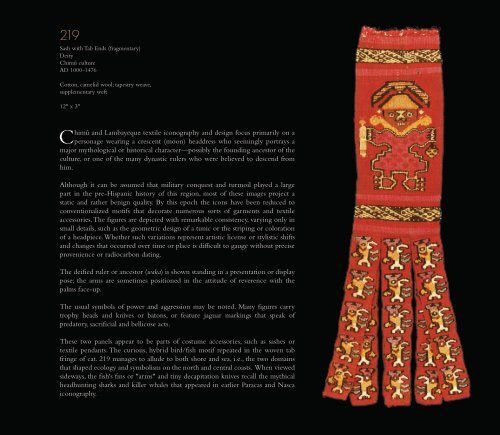You also want an ePaper? Increase the reach of your titles
YUMPU automatically turns print PDFs into web optimized ePapers that Google loves.
219<br />
Sash with Tab Ends (fragmentary)<br />
Deity<br />
Chimú culture<br />
AD 1000-1476<br />
Cotton, camelid wool; tapestry weave,<br />
supplementary weft<br />
12" x 3"<br />
Chimú and Lambayeque textile iconography and design focus primarily on a<br />
personage wearing a crescent (moon) headdress who seemingly portrays a<br />
major mythological or historical character—possibly <strong>the</strong> founding ancestor of <strong>the</strong><br />
culture, or one of <strong>the</strong> many dynastic rulers who were believed to descend from<br />
him.<br />
Although it can be assumed that military conquest and turmoil played a large<br />
part in <strong>the</strong> pre-Hispanic history of this region, most of <strong>the</strong>se images project a<br />
static and ra<strong>the</strong>r benign quality. By this epoch <strong>the</strong> icons have been reduced to<br />
conventionalized motifs that decorate numerous sorts of garments and textile<br />
accessories. The figures are depicted with remarkable consistency, varying only in<br />
small details, such as <strong>the</strong> geometric design of a tunic or <strong>the</strong> striping or coloration<br />
of a headpiece. Whe<strong>the</strong>r such variations represent artistic license or stylistic shifts<br />
and changes that occurred over time or place is difficult to gauge without precise<br />
provenience or radiocarbon dating.<br />
The deified ruler or ancestor (waka) is shown standing in a presentation or display<br />
pose; <strong>the</strong> arms are sometimes positioned in <strong>the</strong> attitude of reverence with <strong>the</strong><br />
palms face-up.<br />
The usual symbols of power and aggression may be noted. Many figures carry<br />
trophy heads and knives or batons, or feature jaguar markings that speak of<br />
predatory, sacrificial and bellicose acts.<br />
These two panels appear to be parts of costume accessories, such as sashes or<br />
textile pendants. The curious, hybrid bird/fish motif repeated in <strong>the</strong> woven tab<br />
fringe of cat. 219 manages to allude to both shore and sea, i.e., <strong>the</strong> two domains<br />
that shaped ecology and symbolism on <strong>the</strong> north and central coasts. When viewed<br />
sideways, <strong>the</strong> fish's fins or "arms" and tiny decapitation knives recall <strong>the</strong> mythical<br />
headhunting sharks and killer whales that appeared in earlier Paracas and Nasca<br />
iconography.<br />
185







